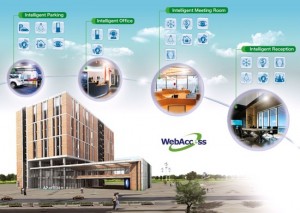In my previous blog article, I talked about the growing emphasis on intelligent building.
To summarize, Intelligent Building can automate the following areas:
- Integrated and Intelligent Systems
- Energy Management System & Services
- Service Support & Maintenance
Advantech’s intelligent building solution (AiBS) software, WebAccess, can accomplish the tasks listed above. WebAccess is a graphical control SCADA/HMI software package providing remote control and management functions to configure, operate, maintain and manage the entire system.
WebAccess is centered on:
- Intelligent parking
- Reception
- Offices
- Meeting rooms
- And security, with the added feasibility of configuring additional and required applications.
 In addition, WebAccess has drivers for close to 100 different brands of equipment and devices utilized for electricity, AC, lighting, fire-emergency, access control, video, audio and more. The most appealing aspect of WebAccess is that everything can be integrated into a single platform, which is a big plus from a compatibility perspective. The support of Draw & View based on HTML5 to assist in displays on operating systems including Windows, iOS and Android is also a huge plus.
In addition, WebAccess has drivers for close to 100 different brands of equipment and devices utilized for electricity, AC, lighting, fire-emergency, access control, video, audio and more. The most appealing aspect of WebAccess is that everything can be integrated into a single platform, which is a big plus from a compatibility perspective. The support of Draw & View based on HTML5 to assist in displays on operating systems including Windows, iOS and Android is also a huge plus.
With WebAccess, cloud services and an array of hardware designed to acquire critical data, display for user interface and make determinations based on outcomes, Advantech has established a reliable Intelligent Building solution.
Subsystems, once treated as isolated functions and automated, if at all, by standalone devices, such as smart thermostats, are now recognized by the most successful intelligent-building designs as highly interrelated aspects of comprehensive automation strategies.
Because major renovations of commercial buildings are typically undertaken only every 25 years or so, intelligent-building systems must be readily expansible and upgradable as usages and technologies evolve during these between-retrofit periods.
The most successful intelligent-building systems are those that were designed with sufficient flexibility to accommodate and take advantage of that rapidly-developing trend. Intelligent-building systems must, therefore, be both comprehensive enough to address all critical subsystems yet flexible enough for expansion to address new subsystems and emerging technologies.













